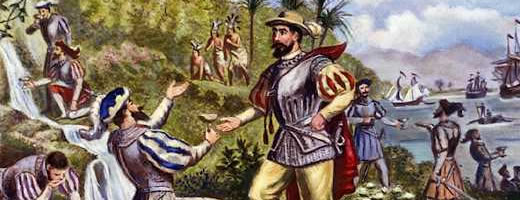Spanish Exploration
Sunday of the Palms (Healthy Pascua) of the 1513 navigator Spanish Juan Ponce de León (photo) touched the coast of Florida with his three ships and took possession of the new territory in the name of the king of Spain, calling it Healthy in honor of the festivity day. In reality, de León was searching for gold, and the territory was pushed to the Gulf of Mexico, exploring nearly Vergine, covered with forests and populated by aborigines, generally hostile.
In fact, they were killed by an arrow during a successive shipment in 1521.
Spanish Settlements
 For approximately 50 years, other Spanish expeditions followed, some trying to establish stable settlements until the first French Huguenot appropriation was destroyed by Admiral Pedro Menéndez de Avilés under orders from King Philip II of Spain. Menéndez, named governor of Florida, founded the most ancient permanent settlement in North America, the city of St. Augustine (1565).
For approximately 50 years, other Spanish expeditions followed, some trying to establish stable settlements until the first French Huguenot appropriation was destroyed by Admiral Pedro Menéndez de Avilés under orders from King Philip II of Spain. Menéndez, named governor of Florida, founded the most ancient permanent settlement in North America, the city of St. Augustine (1565).
Colonization and Missionary Work
The colonization of Florida involved not only military work but also Jesuit and Franciscan missionaries, who tried to convert the indigenous population, pushing deep into the peninsula, much of which remained unexplored. English and French expansionist ambitions caused frequent clashes with the Spanish, whose outposts, including St. Augustine, were often besieged. The Spanish established permanent settlements in Pensacola and expanded dominion over the region.
Florida Under British and Spanish Control
At the end of the Seven Years’ War (1763), Florida was ceded to the English but returned to Spain after the American War of Independence. During the English period, agriculture and colonization expanded remarkably. Under Spanish control, tensions with the United States persisted until 1818, when Andrew Jackson waged war against the Seminole Indians in Florida (First Seminole War), occupying part of the territory.
American Acquisition and Early Development
After a series of conflicts, Spain ceded Florida to the USA through the Adams-Onís Treaty (1819), ratified in February 1821. Florida became a U.S. territory, with St. Augustine as its first administrative center, later moved to Tallahassee in 1824. Pre-Civil War Florida saw agricultural expansion (cotton, maize, sugarcane, tobacco, citrus) and technical progress with railroads, infrastructure, and city growth.
Second Seminole War
At the same time, Florida faced the Second Seminole War, as indigenous peoples resisted relocation to reservations, led by Osceola, who was eventually captured and died in jail (1837). The war decimated the Seminole population, leaving only a few hundred in the Everglades.
Statehood and Civil War
In 1845, Florida became the 27th state of the USA. Its economy relied on agriculture worked by enslaved people, and the political class was dominated by wealthy landowners. Florida joined the Confederacy during the Civil War (1860), contributing agricultural products and ports to the effort.
Reconstruction
After the conflict (1865), Florida was under military occupation for some years, with a new constitution and a Republican government led by Harrison Reed (1868). Republicans remained in power until 1877, when Democrats regained control for nearly a century. Florida began economic and demographic growth with immigration, tourism (especially Miami and Miami Beach), and industry, improving infrastructure.
Economic Expansion and Tourism
Reclamation and phosphate discoveries (1880) allowed cultivation and industrial growth. Post-WWI real estate development expanded cities, fueled by tourism in Miami and Miami Beach and the mild year-round climate. This prosperity continued after WWII.
Modern Florida
In later years, conservative politics prevailed, culminating in the election of a Republican governor (1966). Florida now faces challenges of wealth concentration, migration from South America, Cuba, and other U.S. states, creating a multiracial society with integration challenges.
Miami and Miami Beach Today
Florida, particularly Miami and Miami Beach, is central to trade with Latin America, including legal and illegal markets. Immigration contributes to a complex social landscape: some integrate successfully, while others live in marginal conditions, often relying on informal or illegal activities. Miami also hosts a notable Haitian community, centered in Little Haiti.










